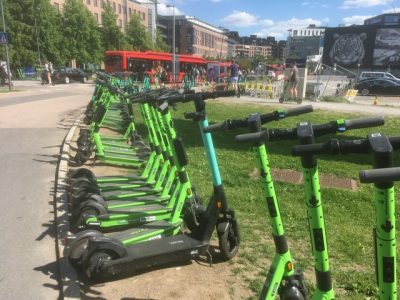UPDATED: New state laws will give local communities more rights to regulate the availability and use of electric scooters that have sparked chaos in towns and cities all over Norway. From July 1, they’ll be able to set up parking signs, enforce speed limits and further reduce use of the popular but problematic scooters this autumn.

The City of Oslo has already sent out to hearing a long list of regulatory measures in addition to those already being put into place. It means the tougher measures, aimed at reducing the numbers of scooters now on the streets, won’t take effect until the end of August at the earliest, but pedestrians may finally be able to feel safer on the sidewalks again.
The Parliament did approve its own proposed scooter rules that make it easier for municipalities to enforce their own. Oslo wants to have a maximum of 8,000 scooters available for rental, down from the roughly 25,000 now on the streets and, most controversially, the sidewalks.
The 8,000 scooters would be spread over four zones within the city, with only 1,200 allowed in the downtown area where scooter traffic has been heaviest and most dangerous. Newspaper Aftenposten reported recently that Oslo’s emergency hospital registered 250 accidents in May alone, compared to 90 in May of last year.
There have been more accidents in recent days, including one in which a scooter-rider hit a six-year-old child playing in a public square at Hasle in Oslo. Then came news that neither police not transport officials have been fining those violating new rules that forbid more than one person riding on a scooter, or for riding too fast. Even though they can now issue fines of up to NOK 3,000 (USD 360), they contend they don’t yet have the digital platforms in place to hand out and register tickets, nor are they equipped to measure scooters’ speed, and thus be able to confirm violations of speed limits.
Drunk-driving restrictions ‘complicated’
Most scooter ccidents occur late at night and involve drivers and riders who are drunk. A recent public opinion poll showed that fully 90 percent of those questioned want vehicle blood-alcohol limits of 0.2 percent to apply to those on scooters, but the state transport ministry didn’t include that in its regulatory wrap just prior to Parliament’s recess.
Transport Minister Knut Arild Hareide of the Christian Democrats said a crackdown on drunken scooter-driving is still being addressed, because the ministry would either need to propose reclassifying el-scooters as a motorized vehicle (in which case scooters would be subject to the same rules as cars), create a new law with blood-alcohol limits specifically for small electric vehicles like scooters, or put a blood-alcohol limit on bicycles and electric bicycles as well. That’s because scooters are currently viewed as a form of bicycle instead of a motorized vehicle.
That’s the main problem, editorialized newspaper Dagsavisen on Wednesday. “What we really need is a reclassification of el-scooters … and we should give them a more precise name. How about a ‘standing moped?'”
In order to comply with laws already in force, restrictions on riding while drunk can only be implemented by regulating when the scooters can be used. The City of Oslo is thus proposing a ban on usage between 1am and 5am, the same time span when most accidents involving drunkenness have occurred. Scooter operator Voi conducted its own informal and voluntary testing of users’ alcohol levels in Oslo last Sunday evening: More than 20 tested over the 0.2 limit for motorists. One man had a blood-alcohol level as high as 1.48, and he rode off right after the test.
Restrictions on use of the el-scooters can be programmed into them. That means a user wouldn’t be able to get a scooter to function between 1am and 5am, while others will be programmed to only operate in certain areas of the city.
Chaos may continue
Debate continues to rage over the el-scooters that now are widely viewed as a hazard to pedestrians and others. Top city officials around Norway still think it will take lawsuits heading all the way to the Supreme Court to ultimately determine how regulation can occur.
Many agree that the biggest mistake was made when Norway’s conservative government coalition, under pressure from the Progress Party at the time, put el-scooters on an equal footing with bicycles, use of which is largely unregulated as well. Scooter operators like Ryde contend that current and looming regulations can’t stop them under existing law, and Ryde has already won several cases that challenged municipal authority.
Calls have gone out to ban el-scooters entirely but that’s now considered unrealistic. Operators are already protesting over the planned reduction in those allowed to operate, with Christina Moe Gjerde of scooter rental firm Voi calling it a “catastrophe.” Officials at Voi rival Lime, however, think an ongoing lack of regulation would be worse.
“We support the city’s proposals 100 percent,” said Limes “senior manager” for public affairs in the Nordic countries, Fredrik Timell. Another public opinion poll, meanwhile, showed that only 9 percent of those questioned support a total ban, while 73 percent think they should be regulated more strictly than now. Oslo residents will, at any rate, have to put up with the more than 20,000 on the streets through the summer and hope for better control this fall.
newsinenglish.no/Nina Berglund

